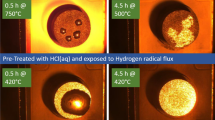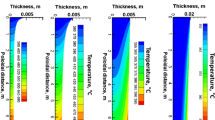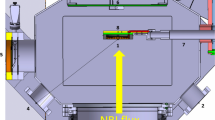Abstract
The Hybrid Illinois Device for Research and Applications (HIDRA) at the University of Illinois at Urbana-Champaign is a toroidal plasma device that enables fusion plasma-material interaction testing with both stellarator and tokamak plasmas. HIDRA’s long-pulse steady state stellarator plasmas provide a testbed for plasma facing component (PFC) plasma exposures. The HIDRA Material Analysis Test-stand (HIDRA-MAT) is a material characterization module attached to HIDRA that is being designed and fabricated to include thermal desorption spectroscopy and laser induced breakdown spectroscopy systems for in-vacuo PFC characterization. A specialized rotatable sample holder positions the sample for liquid metal droplet application from a liquid metal droplet injector on HIDRA-MAT. Early experiments look to investigate the effect liquid lithium has on porous tungsten samples’ retention of H, D, and He after plasma exposure. Preliminary results from a dual residual gas analyzer system show the ability to differentiate D2 and He in HIDRA-MAT. This work aims to advance the understanding of liquid metal PFCs and further the design and development of new fusion PFCs and technologies.







Similar content being viewed by others
References
P. Fiflis, N. Connolly, D.N. Ruzic, Experimental mechanistic investigation of the nanostructuring of tungsten with low energy helium plasmas. J. Nucl. Mater. 482, 201 (2016)
D.H. Liu, S.Y. Dai, M. Wada et al., Modelling of hydrogen reflection on tungsten fuzzy surface in an erosive hydrogen plasma. Nucl. Fusion 60, 056018 (2020)
Z.S. Hartwig, H.S. Barnard, B.N. Sorbom et al., Fuel retention measurements in Alcator C-Mod using accelerator-based in situ material surveillance. J. Nucl. Mater. 463, 73–77 (2015)
D.N. Ruzic, W. Xu, D. Andruczyk et al., Lithium–metal infused trenches (LiMIT) for heat removal in fusion devices. Nucl. Fusion 51, 102002 (2011)
D. Andruczyk, R. Maingi, J.S. Hu et al., Overview of lithium injection and flowing liquid lithium results from the US–China collaboration on EAST. Phys. Scr. T171, 014067 (2020)
D.N. Ruzic, M. Szott, C. Sandoval et al., Flowing liquid lithium plasma-facing components—physics, technology and system analysis of the LiMIT system. Nucl. Mater. Energy. 12, 1324–1329 (2017)
R. Rizkallah, D. Andruczyk, A. Shone et al., Latest results from the Hybrid Illinois Device for Research and Applications (HIDRA). IEEE Trans. Plasma Sci. 46(7), 2685–2690 (2018)
S. Marcinko, D. Curreli, Numerical characterization of the edge transport conditions and limiter fluxes of the HIDRA stellarator. Phys. Plasmas. 25, 022507 (2018)
C.N. Taylor, B. Heim, S. Gonderman et al., Materials analysis and particle probe: a compact diagnostic system for in situ analysis of plasma-facing components. Rev. Sci. Instrum. 83, 10D703 (2012)
H. Moriyama, K. Iwasaki, Y. Ito, Transport of tritium in liquid lithium. J. Nucl. Mater. 191–194, 190–193 (1992)
R. Rizkallah, S. Marcinko, D. Curreli et al., Mapping of the HIDRA stellarator magnetic flux surfaces. Phys. Plasmas. 26, 092503 (2019)
P. Fiflis, A. Press, W. Xu et al., Wetting properties of liquid lithium on select fusion relevant surfaces. Fusion Eng. Des. 89, 2827–2832 (2014)
M. Zibrov, Yu Gasparyan, S. Ryabtsev et al., Isolation of peaks in TDS spectra of deuterium from ion irradiated tungsten. Phys. Procedia. 71, 83–87 (2015)
P.Y. Achener, Alkali Metals Evaluation Program. Rep. AGN-8202, Aerojet-General Corp., Nov. 1966.
J.W. Taylor, The surface energies of the alkali metals. Phil. Mag. 46, 867–876 (1955)
D. Alpert, New developments in the production and measurement of ultra high vacuum. J. Applied Phys. 24, 860 (1953)
C. Li, C. Feng, H.Y. Oderji et al., Review of LIBS application in nuclear fusion technology. Front. Phys. 11(6), 114214 (2016)
Y. Yu, J. Hu, Z. Wan et al., Mass separation of deuterium and helium with conventional quadrupole mass spectrometer by using varied ionization energy. Rev. Sci. Instrum. 87, 035120 (2016)
A. de Castro, A. Sepetys, M. Gonzalez, et al., Temperature dependence of liquid lithium film formation and deuterium retention on hot W samples studied by LID-QMS. Implications for future fusion reactors. Nucl. Fusion 58:046003 (2018)
Acknowledgements
This work is supported by the Department of Energy DESC0017719, by the University of Illinois Grainger College of Engineering, the Department of Nuclear, Plasma, and Radiological Engineering, the Office of the Vice Chancellor of Research, Facilities, Services at the University of Illinois at Urbana-Champaign and Institute for Plasma Physics.
Author information
Authors and Affiliations
Corresponding author
Additional information
Publisher's Note
Springer Nature remains neutral with regard to jurisdictional claims in published maps and institutional affiliations.
Rights and permissions
About this article
Cite this article
Shone, A., Koyn, Z., Rizkallah, R. et al. An Overview of the Hybrid Illinois Device for Research and Applications Material Analysis Test-stand (HIDRA-MAT). J Fusion Energ 39, 448–454 (2020). https://doi.org/10.1007/s10894-020-00260-7
Accepted:
Published:
Issue Date:
DOI: https://doi.org/10.1007/s10894-020-00260-7




